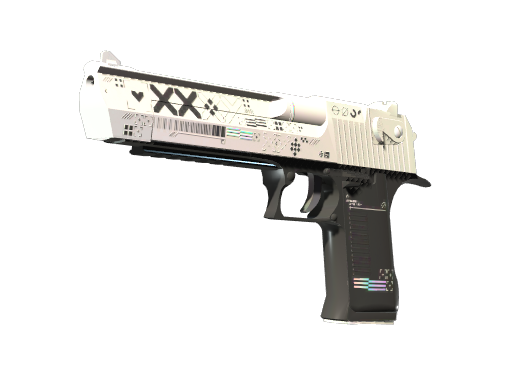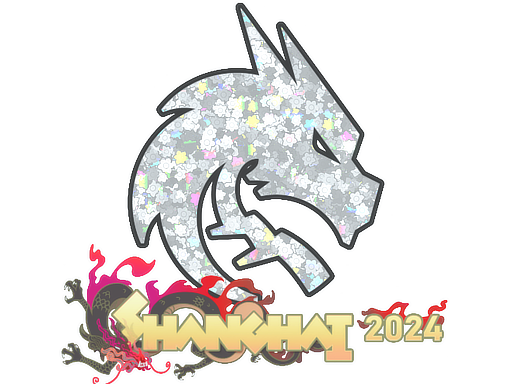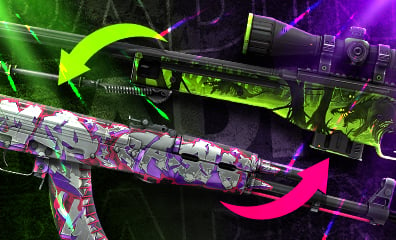The Evolution of CS:GO (CS2) Skins: Changes and Updates by Valve
Throughout its existence, Counter-Strike has experienced a remarkable metamorphosis, especially concerning weapon skins. With the “Arms Deal” update in 2013, Valve introduced skins, revolutionizing the game’s cosmetic landscape. Since then, Valve has been consistently improving and perfecting CS:GO (CS2) skins, resulting in an exhilarating evolution of the in-game cosmetic system. In this article, we will delve into the evolution of CS:GO (CS2) skins, exploring the changes and updates introduced by Valve.
Why Valve Changes CS:GO (CS2) Skins
Valve, the developer of CS, makes occasional adjustments to skins in the game for various reasons. One primary motive for these changes is to ensure a fair and balanced gameplay experience. Some skins with bright or distinct colors might unintentionally give players an advantage, making them harder to spot in certain environments, particularly in competitive matches. To address this concern, Valve may modify the colors or patterns of these skins to maintain a level playing field.
Another reason for skin changes is to improve the overall aesthetics and quality of the game. Valve takes player feedback and market trends into account when updating skins. If a particular skin receives negative feedback or lacks popularity within the community, Valve may make adjustments to enhance its visual appeal and appeal to a broader audience.
As the game evolves and new features are introduced, Valve may update older skins to be compatible with these changes. For example, when Valve introduced wear and float values for weapon skins, they retroactively applied these attributes to existing skins. This ensures consistency among all skins and provides players with a uniform experience.
Valve periodically introduces new cases or collections with fresh skins and designs. These additions keep the game exciting and encourage players to explore new skin options and invest in the game’s cosmetic items. Valve’s changes to CS:GO (CS2) skins serve to maintain gameplay balance, improve visual aesthetics, and adapt to the game’s ongoing evolution. These efforts create an engaging and dynamic experience for players and collectors while ensuring the long-term sustainability of the CS ecosystem.
CS:GO (CS2) Skins with DMCA Violations
Counter-Strike boasts an extensive in-game skins marketplace, granting players the chance to personalize their weapons and gear. However, the widespread popularity of these skins has given rise to certain problems, such as the existence of skins that violate the Digital Millennium Copyright Act (DMCA).
DMCA violations occur when CS:GO (CS2) skins utilize copyrighted materials without obtaining proper authorization from the original copyright holder. These unauthorized skins may incorporate logos, designs, or artwork from famous brands, movies, games, or other copyrighted sources. By creating and distributing such skins without permission, individuals are infringing upon intellectual property rights. Valve treats copyright violations with utmost seriousness and has established a system to address DMCA takedown requests. When copyright holders identify skins that violate their rights, they can submit a DMCA takedown notice to Valve. Upon receiving a valid notice, Valve is obligated to remove the infringing skins from the game and the Steam Marketplace.
The presence of skins with DMCA violations can result in various repercussions. Players who own or trade such skins may discover them removed from their inventories, leading to a loss of value. Additionally, those who knowingly create and distribute infringing skins may face legal consequences from the copyright holders. To avoid any dealings with skins featuring DMCA violations, players should exercise caution when trading or purchasing skins from third-party websites or marketplaces. Trustworthy platforms usually ensure that the skins listed for trade or sale are legitimate and do not infringe on copyright laws. Engaging in transactions within the official Steam Marketplace can also mitigate the risk of encountering unauthorized skins.
Despite the exciting opportunities CS:GO (CS2) skins offer for personalization, players must be mindful of the potential presence of skins with DMCA violations. Valve’s commitment to addressing copyright infringement through DMCA takedowns helps uphold the integrity of the game’s marketplace. Players are advised to engage in responsible trading and purchasing from reputable sources to avoid any complications related to copyright violations.
In Counter-Strike, a game known for its diverse range of skins, there have been instances of DMCA (Digital Millennium Copyright Act) violations related to certain skins. Some skins received DMCA notices for unauthorized use of copyrighted art, leading to necessary adjustments. Notable examples include the M4A1-S Chantico’s Fire and AK-47 Frontside Misty, which underwent minor design changes to comply with copyright regulations.
The M4A4 Griffin attracted attention due to its resemblance to art from the Magic: The Gathering card “Scavenging Ooze,” resulting in a copyright dispute. To avoid legal issues, Valve had to redraw the mythical creature featured on the skin.

The M4A4 Howl presented another unique case of copyright infringement. Its original design, depicting a wolf with distinctive art, was found to have been taken from copyrighted artwork. To address the matter, Valve not only changed the design but also adjusted the skin’s rarity and removed it from cases and collections. A new design replaced the M4A4 Howl to prevent further copyright complications.

Similarly, the AWP Doodle Lore faced issues with art theft and was replaced by the AWP Duality, a new skin design that adhered to copyright standards.

These instances of DMCA violations underscore the significance of respecting copyright laws when creating in-game content. By promptly addressing these matters, Valve aims to foster a fair and lawful environment for players and content creators within the CS community.
Adjusting Skins’ Brightness
Adjusting the brightness of skins in CS:GO (CS2) is a technique used by some players to improve visibility and clarity while in-game. This practice involves modifying the appearance of skins to make them stand out more prominently in different lighting conditions or environments. The process of adjusting skin brightness can vary depending on individual preferences and the tools available. Some players may use external software or graphics settings to alter the brightness and contrast of their skins, while others may use in-game console commands or custom shader settings.
The primary goal of adjusting skin brightness is to make them more visible and distinguishable during gameplay, especially in darker or dimly lit areas. This can be particularly helpful in competitive matches, where players need to quickly identify opponents and their weapon types.
There are several ways to adjust skins’ brightness in CS:GO (CS2):
- Graphics Card Settings: One of the methods is to adjust skin brightness involves using the graphics card settings. Players can access their graphics card control panel (e.g., NVIDIA Control Panel or AMD Radeon Settings) and fine-tune the color and gamma settings. Tweaking these settings can affect the overall brightness of the game, including weapon skins
- In-Game Settings: CS:GO (CS2) offers a built-in option to adjust the brightness of weapon skins through the game’s video settings. Players can navigate to the “Video” settings menu and find the “Shader Detail” option. Lowering the shader detail setting may reduce the brightness of skins while raising it can make skins appear brighter. However, it’s important to note that adjusting the shader detail may impact the overall visual quality of the game.
- Third-Party Software: Certain third-party software tools may offer more advanced customization options for skin brightness. However, it’s important to be cautious when using third-party software, as some may violate CS’s terms of service and could result in a ban
- Custom Skins: Some players create or download custom skins with adjusted brightness levels. These custom skins can be installed in the game, providing a unique appearance and brightness that suits the player’s preference.
It is essential to note that modifying skins’ brightness is a controversial practice and may not be allowed in official competitive matches or tournaments. Some leagues and organizations have strict rules against any alterations to in-game files or settings that provide an advantage over other players. Valve has also expressed its stance against any form of cheating or unfair advantage in the game. While adjusting skin brightness might not be considered a direct cheat, it falls under the category of modifying in-game files, which could result in penalties or bans if detected by the game’s anti-cheat system.
As with any modifications to the game, players should exercise caution and adhere to the rules set by the game’s developer and competitive organizations. It’s essential to prioritize fair play and sportsmanship to maintain the integrity of the CS community and ensure an enjoyable experience for all players.
Recoloured Skins
Recolored skins in CS:GO (CS2) are custom or modified weapon skins that feature changes to their color schemes. These skins are created by the community or individual players and are not official additions from the game developer, Valve.
Players can adjust the colors of existing skins or create entirely new ones using external software or custom shader settings. Recolored skins provide players with a way to personalize their weapons and showcase their creativity in the game. The CS community has embraced recolored skins, resulting in a wide variety of custom designs available for download or sharing. These custom skins are purely cosmetic and do not affect gameplay mechanics, ensuring a fair playing experience for all users.
Players value recolored skins for various reasons:
- Personal Touch: Recoloured skins enable players to personalize their weapons according to their unique style and preferences. With a broad array of color choices, players can craft skins that align with their favorite colors or complement their in-game appearance and overall loadout.
- Visual Appeal: Many such skins offer a refreshing and visually attractive twist on familiar designs. The distinctive color combinations make weapons stand out on the battlefield, captivating both players and onlookers.
- Community Spirit: The creation of recolored skins is a collective endeavor that highlights the artistic talent within the Counter-Strike player community. This cultivates a sense of camaraderie and creativity among players who contribute to the array of custom skins accessible to the community
Recolored skins are visible only to the player who applied them and others using the same custom skin files. Players who don’t have the specific custom skin installed will see the default skin for the weapon.
While recolored skins allow players to express themselves and add uniqueness to the game, it’s essential to use them responsibly and adhere to community guidelines. Any modifications that could be seen as cheating or providing an unfair advantage in competitive play should be avoided. Recolored skins offer players an extra layer of customization and individuality in CS, contributing to the diverse and dynamic in-game community.
Valve Also Changed Stickers due to DMCA
Valve has faced instances where in-game stickers had to be altered or removed due to concerns related to the Digital Millennium Copyright Act (DMCA). Stickers are highly popular in Counter-Strike 2, enabling players to customize their weapons and gear with various designs, logos, and artwork.
Some stickers have been discovered to include copyrighted materials without proper authorization from the original copyright owners. When copyright holders identify these unauthorized stickers, they can send DMCA takedown notices to Valve, requesting the removal of these infringing items from the game.
Valve responds to these DMCA takedown requests promptly, aiming to adhere to copyright laws and maintain compliance. The response may involve altering or entirely removing the stickers in question, thereby mitigating potential legal consequences and upholding intellectual property rights. This process of changing or removing stickers due to DMCA violations is crucial to preserving the integrity of CS’s in-game items while respecting copyright laws. Valve’s goal is to ensure a fair and lawful marketplace for players to enjoy a variety of customization options without infringing upon copyright materials.
As a result of these actions, players may observe certain stickers being modified or no longer available in the game’s marketplace. Although such changes might disappoint some players, they are vital to safeguard Valve and the CS community from potential copyright infringement issues. To prevent further complications and maintain compliance with copyright regulations, Valve actively encourages players to create stickers using original and non-infringing materials. By respecting intellectual property rights, the CS community can continue enjoying a diverse range of stickers without encountering any DMCA-related problems in the future.
Wrapping Up!
Valve’s purpose in altering CS:GO (CS2) skins is to ensure balanced gameplay, prevent unintentional advantages, and enhance aesthetics through player input and market trends. Additionally, they promptly address copyright issues by responding to DMCA violations and making necessary adjustments. While skins and stickers contribute to a diverse community, players must be cautious about copyright laws when using or trading custom skins for a pleasant and lawful experience. For more information and updates on CS:GO (CS2) skins and the latest developments, visit our blog to stay informed and engaged with the community. Valve’s continuous efforts improve CS:GO’s (CS2) skins, fostering an engaging and equitable environment for all players.
Why did Valve change skins?
Valve made changes to CS:GO (CS2) skins for several reasons. One of the main motivations was to ensure a fair and balanced gameplay experience. Some skins with vibrant or unique colors unintentionally gave players an advantage by making them harder to spot in certain environments, especially during competitive matches. To rectify this issue and promote fairness, Valve would modify the colors or patterns of specific skins. If a particular skin received negative feedback or lacked popularity within the community, Valve would make necessary adjustments to enhance its visual appeal and appeal to a wider audience.
Share to:








